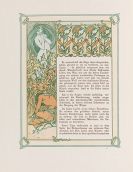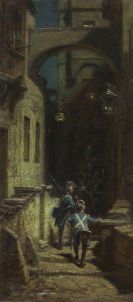
Alfons Mucha
Eibenschütz in Mähren
1860 -
Prag
1939
Alfons Mucha was born in Southern Moravia on July 24, 1860. At the age of seventeen the artist left his home, to work as a painter of stage decorations at the Vienna "Ringtheater". When there was a fire at the theater, Mucha lost his job. He found new employment at the Vienese castle with Count Khuen, who became his patron and sent him to the Munich art academy a few years later. From there, Alfons Mucha went on to Paris in 1887 to continue his studies at the "Académie Julian" and then at the "Académie Colarossi".
Due to a lack of financial support from Khuen, however, the student was forced to leave the academy and earn a living as an illustrator. During this time he produced a large number of sketches and drawings. These were studies for illustrations, which were later published in "Figaro illustré", "Petit Parisien illustré" and other journals.
This early work and the prints for illustrated books like "L´éléfant blanc" by Judith Gauthier, at which Alfons Mucha worked during this time, still reflect the usual academic historic style of the time. By coincidence, thanks to an employer of Lemercier printers, Mucha was commissioned to design a poster for Sarah Bernhardt in 1894. This provided the launchpad for Mucha's future success and importance as an influencial designer of French "Art Nouveau".
Sarah Bernhardt was impressed by the artist's work. From then on, the famous actress not only had Mucha design her posters but also her costumes and stages. The public also liked Mucha's works very much and he became a famous, widely talked about and celebrated master almost over night.
Around 1900 Alfons Mucha reached the peak of his fame. Mucha's theoretical theses "Documents Décoratives" and "Figures Décoratives" influenced the applied art of the time significantly. From now on, people talk about "Mucha style" whose typical elements like the arabesque hair and the aureole surrounding the female profile, were often copied.
In 1900 Alfons Mucha took part in the Paris World Exposition, evoking general attention with his wall decorations in Bosnia and Herzegovina's pavilion. In 1904 Alfons Mucha went to America, where he produced wall decorations, stages settings and portraits during a prolonged stay in New York. Alongside he taught drawing and compostition at the Chicago Art Institute.
After Mucha's return to his home country, shortly before World War I, he dedicated considerable time to lithographic work. Then he became increasingly occupied by a series of 20 pictures entitled "Lépopée Slave", the "Slavian Epos". Mucha finished the large format continuation (6 x 8m) of the decoration of the Bosnian pavilion in 1928 and donated it to the city of Prague.
Alfons Mucha died in Prague shortly before the invasion of Czechoslovakia by German troops on July 14, 1939.
Would you like to sell a work by Alfons Mucha?
Infos for seller






